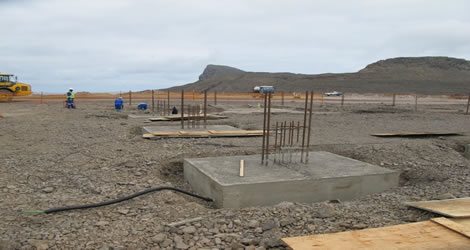The St Helena Airport is an international airport on a remote island on the west of the coast of southwestern Africa. Construction on the airport began in early 2012 and after several setbacks, the runway was finally completed in 2015. The project has an estimated total cost of about €270 million.
St Helena Airport which is part of the British Overseas Territory of Saint Helena became operational in 2016. Although the airport’s inaugural scheduled flight was delayed, it was able to offer general aviation, charter, and medical evacuation flights from May 2016. Commercial passenger lines became operational at the airport on 14 October 2017.
Basil Read is serving as the operator of the Saint Helena Airport. The South African construction group is under a year contract to operate the airport.
Reported in 2015
Basil Read awarded additional US$25 million contracts for St Helena
 Basil Read, JSE-listed construction and engineering group, has been awarded two contracts for additional work on the St Helena Airport project.
Basil Read, JSE-listed construction and engineering group, has been awarded two contracts for additional work on the St Helena Airport project.
The first contract, valued at R244 million (US$24 million), would entail the design and construction of a permanent wharf in Rupert’s Bay which would be part of the overall airport project. The second contract valued at R14 million (US$1.3 million) will entail the construction of the Horsepoint landfill site.
The additional works would be carried out within the existing contract period and are expected to be completed by early 2015. The two-phase airport project which is being undertaken by the St Helena government and funded by the British government’s Department for International Development is valued at £250 million (US$403 million).
The additional contracts along with some additional variations would bring the total value of the St Helena Airport project to about £265 million (US$427 million) for phases 1 and 2.
Basil Read CEO said they are extremely pleased to have secured the additional contracts, especially since Basil Read is already active in the construction of the airport on St Helena Island. Enormous progress has been made in the past two years on Phase 1 in terms of the airport and preparations in general across St Helena.
The construction of St Helena Airport has reached new heights as the gorge being raised to carry parts of the runway has hit a new milestone. St Helena Airport is due to be completed in 2016.
November 3, 2013, marked exactly two years since the signing of the airport contract between St Helena Government and Basil Read. Back in 2011, Basil Read was awarded the contract to design, build and operate the airport. Two years on and the progress is evident in the remarkable amount of work that has taken place both at the airport site and in Rupert’s Valley. Work continues on constructing the combined and terminal buildings at Prosperous Bay, as well as continuing work on the Access Road and Bulk Fuel Installation at Rupert’s. Public consultation on the amendment to the Rupert’s Wharf Plan is also currently progressing.
The first considerations for an airport on St Helena, the British Overseas Territory, a remote island in the South Atlantic Ocean located more than 2,000 kilometers from the nearest major landmass which can currently only be reached by ship were made in 1943 by the South African Air Force which undertook a survey on Prosperous Bay Plain from October 1943 until January 1944 but concluded that while technically feasible, an airport was not a practical proposition.
In the 1960s there was an idea to build an airport on St Helena Island. In 1999, this was taken up by the island government. After a long period of rumor and consultation, the British government announced plans to construct an airport in Saint Helena in March 2005, and the airport was originally expected to be completed by 2010.
However constant delays by the British government not least due to inaction by Prime Minister Gordon Brown who insisted on reviewing the paperwork himself meant an approved bidder, the Italian firm Impregilo, was not chosen until 2008. Then the project was put on hold in November 2008, allegedly due to new financial pressures brought on by the credit crunch.
By January 2009, construction had not commenced and no final contracts had been signed, and the then Governor Andrew Gurr departed for London in an attempt to speed up the process and solve the problems. On 22 July 2010, the new British government agreed to help pay for the new airstrip using taxpayer money. It was only on 3 November 2011 that the new Island Governor Mark Capes announced construction contracts were signed.
The airport is expected to open in 2016, by which time the RMS Saint Helena, the only regular ship to call at St Helena, will be retired. Its advocates hope the airport will bring growth to the isolated island economy through the tourism sector which, in the long term, is expected to lead to financial self-sustainability and an end to UK budgetary aid.
